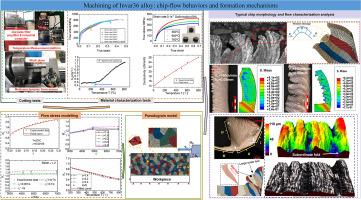因瓦 36 合金的加工:切屑流动行为和形成机制
IF 6.8
1区 工程技术
Q1 ENGINEERING, MANUFACTURING
引用次数: 0
摘要
本研究深入探讨了造成因瓦 36 合金独特切屑形成的塑性变形机制,其特点是加工过程中的劈裂和折叠不稳定性。本研究通过切削实验和材料性能测试揭示了因瓦 36 合金的流动特性,并由此建立了流动应力模型。通过多晶有限元模拟,研究揭示了晶间压缩如何诱发表面隆起,进而引发拉伸应力下的裂纹。随着切削速度的加快,塑性流动的加剧导致切屑锯齿越来越明显和频繁。当切削速度超过 200 米/分钟时,温度和应变率的升高会导致材料屈曲并粘附在刀具的前刀面上,从而产生大面积的附属褶皱。这种 "扇形 "切屑结构会产生自阻塞效应,进而产生巨大的切削力和剧烈振荡。通过数学物理模型分析发现,切削力的振荡会激发材料的惯性反应,催化剪切应变和剪切应变率的突然变化,最终导致切削区域内出现裂纹和分割。最后,研究简要讨论了切削流动机制的这些变化对因瓦 36 合金实际加工中刀具磨损和表面质量的影响,并概述了未来的研究方向。本文章由计算机程序翻译,如有差异,请以英文原文为准。

Machining of Invar 36 alloy: Chip-flow behaviors and formation mechanisms
This investigation delves into the plastic deformation mechanisms responsible for the distinctive chip formation of Invar 36 alloy, marked by features of cleavage and folding instabilities during machining. This study unveils the flow characteristics of Invar 36 alloy by conducting cutting experiments and material property tests, leading to the formulation of flow stress models. Employing polycrystalline finite element simulation, the research illuminates how intergranular compression can induce surface bulging, subsequently triggering the initiation of cracks under tensile stress. As cutting speeds escalate, an intensification in plastic flow begets increasingly pronounced and frequent chip serrations. When speeds surpass 200 m/min, elevated temperatures and strain rates foster material buckling and adhesion to the tool's rake face, fostering the emergence of large-scale and subsidiary folds. This “fan-like” chip architecture precipitates a self-blocking effect, which in turn generates significant cutting forces and severe oscillations. An analysis via a mathematical-physical model reveals that the oscillation in cutting force incite the material's inertial responses, catalyzing abrupt shifts in shear strain and shear strain rate, and eventually leading to cracks and segmentation within the cutting zone. Finally, the research briefly discussed on the ramifications of these alterations in the cutting flow mechanism on tool wear and surface quality in the practical machining of Invar 36 alloy, alongside an outline of prospective research.
求助全文
通过发布文献求助,成功后即可免费获取论文全文。
去求助
来源期刊

Journal of Manufacturing Processes
ENGINEERING, MANUFACTURING-
CiteScore
10.20
自引率
11.30%
发文量
833
审稿时长
50 days
期刊介绍:
The aim of the Journal of Manufacturing Processes (JMP) is to exchange current and future directions of manufacturing processes research, development and implementation, and to publish archival scholarly literature with a view to advancing state-of-the-art manufacturing processes and encouraging innovation for developing new and efficient processes. The journal will also publish from other research communities for rapid communication of innovative new concepts. Special-topic issues on emerging technologies and invited papers will also be published.
 求助内容:
求助内容: 应助结果提醒方式:
应助结果提醒方式:


